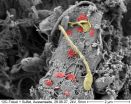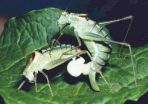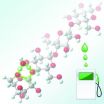(Press-News.org) This press release is available in German.
Leipzig. Remains of dead bacteria have far greater meaning for soils than previously assumed. Around 40 per cent of the microbial biomass is converted to organic soil components, write researchers from the Helmholtz Centre for Environmental Research (UFZ), the Technische Universität Dresden (Technical University of Dresden) , the University of Stockholm, the Max-Planck-Institut für Entwicklungsbiologie (Max Planck Institute for Developmental Biology) and the Leibniz-Universität Hannover (Leibniz University Hannover) in the professional journal Biogeochemistry. Until now it was assumed that the organic components of the soil were comprised mostly of decomposed plant material which is directly converted to humic substances. In a laboratory experiment and in field testing the researchers have now refuted this thesis. Evidently the easily biologically degradable plant material is initially converted to microbial biomass which then provides the source material to soil organic matter.
Soil organic matter represent the largest fraction of terrestrially bound carbon in the biosphere. The compounds therefore play an important role not only for soil fertility and agricultural yields. They are also one of the key factors controlling the concentration of carbon dioxide in the atmosphere. Climatic change can therefore be slowed down or accelerated, according to the management of the soil resource.
In laboratory incubation experiment, the researchers initially labelled model bacteria with the stable isotope 13C and introduced the bacteria to soil deriving from the long-term cultivation experiment "Ewiger Roggenbau" in Halle/Saale. Following the incubation time of 224 days the fate of the carbon of bacterial origin was determined. "As a result we found fragments of bacterial cell walls in sizes of up to 500 x 500 nanometres throughout our soil samples. Such fragments have also been observed in other studies, but have never been identified or quantified", declares Professor Matthias Kästner of the UFZ. The accumulation of the bacterial cell wall fragments appears to be supported by peptides and proteins from the liquid interior of the cells, which remain to a greater extent in the soil than other cell components. These materials enable the formation of a film of organic molecules on the mineral components of the soil, on which the carbon from the dead bacteria is accumulated and stabilised.
When the fragments of the bacterial cell walls dry out, they may lose their rubber-like properties and can harden like glass. If the soil subsequently becomes moist again, however, under certain circumstances they cannot be re-wetted – an important prerequisite for their degradation by other bacteria. This would provide the simplest explanation for the stabilisation of theoretically easily degradable carbon compounds in soil. "This new approach explains many properties of organic soil components which were previously viewed as contradictory", says Matthias Kästner. In the late 1990s, Kästner and his team arrived at this idea on the basis of earlier investigations on the degradation of environmental contaminants like anthracene in polluted soils of former gas work sites. In these investigations, isotopic analyses revealed bound carbon residues which have been of bacterial origin. With the support of the German Research Foundation (Deutsche Forschungsgemeinschaft; DFG), from 2000 on they began to follow up this clue within the scope of two joint research programmes.
Following the laboratory experiment, the hypothesis was tested in field research. In summer of 2009 the researchers took soil samples in the forefield of the Damma Glacier in the Swiss Canton Uri. In the course of the last 150 years glacier has retreated by around one kilometre. In its place granite rock remained behind, which was gradually recolonised by living organisms accompanied by soil development. Following the formation of new soil the first plants, such as mosses and grasses, were followed by bushes and, later, also by trees. In the meantime, the Damma Glacier, on which a broad range of studies is being conducted, has therefore become an important outdoor laboratory not only for climate researchers, but for ecologists as well. The soil investigated with the samples was between 0 and 120 years old and thus allowed insight into early processes of soil development. Scanning electron microscopic investigations which followed at the Max Planck Institute for Developmental Biology in Tübingen also indicated that the covering of the soil mineral particles by a film comprised of bacterial cell wall residues had increased with the soil age. The results of the outdoor investigations therefore confirmed the hypothesis and the laboratory results. This new knowledge was ultimately made possible by recent advances in scanning electron microscopy, which in the meantime enable the identification and evaluation of the soil nano-components.
The predominant share of the plant debris in fertile soil is thus rapidly processed by micro-organisms, e.g. bacteria, leading to more bacteria and, in turn, also to more cell fragments. This then results in more organic material in the soil. "Even though the greatest part of the organic carbon in the eco-systems is definitively produced primarily by plants, we were able to show that a large part of the organic material is actually comprised of residues of bacteria and fungi. This underscores the importance of bacteria as organisms in all types of soil", summarises Matthias Kästner. Furthermore, they are important for the global climate: The degradation of these organic material results, in mineralisation products and the greenhouse gas carbon dioxide (CO2). According to estimates from Great Britain the amount of CO2 escaping annually to the atmosphere due to the degradation of organic material in the soils of England and Wales is in the order of magnitude by which greenhouse gas emissions are annually reduced there. This means that no rigorous progress in climate protection may be accomplished without first protecting the soil.
INFORMATION:
Publications:
Christian Schurig, Rienk H. Smittenberg, Juergen Berger, Fabio Kraft, Susanne K. Woche, Marc-O. Goebel, Hermann J. Heipieper, Anja Miltner, Matthias Kaestner (2012): Microbial cell-envelope fragments and the formation of soil organic matter: a case study from a glacier forefield. Biogeochemistry.
Published online: DOI: 10.1007/s10533-012-9791-3
The investigations were supported by the German Research Foundation (DFG) within the scope of the SPP1315 DynaCarb project and the European Union within the scope of the ModelPROBE project.
Anja Miltner, Petra Bombach, Burkhardt Schmidt-Brücken, Matthias Kästner (2012). SOM genesis – Microbial biomass a significant source. Biogeochemistry, in press.
Published online: DOI 10.1007/s10533-011-9658-z
The investigations were supported by the German Research Foundation (DFG) within the scope of the SPP1090 BioRefrak project and the European Union within the scope of the ModelPROBE project.
Further information:
Professor Matthias Kästner/ Dr. Anja Miltner/ Dr. Christian Schurig
Helmholtz Centre for Environmental Research (UFZ)
Telephone: 03-41-235-1235
http://www.ufz.de/index.php?de=4459
http://www.ufz.de/index.php?de=4530
http://www.ufz.de/index.php?de=18888
or from
Tilo Arnhold (UFZ press office)
http://www.ufz.de/index.php?de=640
Related links:
EU project ModelPROBE: http://www.ufz.de/modelprobe/index.php?en=18269
DFG project DynaCarb: http://www.spp1315.uni-jena.de/
UFZ core topic water / soil: http://www.ufz.de/index.php?en=20167
Fertile soil doesn't fall from the sky
The contribution of bacterial remnants to soil fertility has been underestimated until now
2012-12-14
ELSE PRESS RELEASES FROM THIS DATE:
Male bushcrickets are in charge when it comes to sex
2012-12-14
This press release is available in German.
All a question of timing: When bushcrickets mate, the male attaches a sticky package, the so-called spermatophore, to the female's abdomen. Alongside the sperm themselves, this 'bridal present' consists of a protein-rich mass that the female eats after mating. It then takes several hours for the sperm to find their way into the female's reproductive tract. But, who decides when that will happen? A study by the Bielefeld biologists Professor Dr. Klaus Reinhold and Dr. Steven Ramm suggests that it is the male who determines the ...
What mechanism generates our fingers and toes?
2012-12-14
Montréal, December 14, 2012 – Dr. Marie Kmita and her research team at the IRCM contributed to a multidisciplinary research project that identified the mechanism responsible for generating our fingers and toes, and revealed the importance of gene regulation in the transition of fins to limbs during evolution. Their scientific breakthrough is published today in the prestigious scientific journal Science.
By combining genetic studies with mathematical modeling, the scientists provided experimental evidence supporting a theoretical model for pattern formation known as the ...
Study fuels insight into conversion of wood to bio-oil
2012-12-14
New research from North Carolina State University provides molecular-level insights into how cellulose – the most common organic compound on Earth and the main structural component of plant cell walls – breaks down in wood to create "bio-oils" which can be refined into any number of useful products, including liquid transportation fuels to power a car or an airplane.
Using a supercomputer that can perform functions thousands of times faster than a standard desktop computer, NC State chemical and biomolecular engineer Dr. Phillip Westmoreland and doctoral student Vikram ...
Problems with mineral metabolism linked with kidney disease progression
2012-12-14
Highlights
In a study of African Americans with kidney disease, levels of mineral metabolites rose over time; those with faster rates of kidney function decline had the greatest increases in metabolites.
Higher baseline levels of metabolites were linked with an increased risk for kidney failure or death independent of kidney function.
Disordered mineral metabolism is more severe in African Americans with chronic kidney disease, which might partially explain why their disease progresses more rapidly to kidney failure.
Washington, DC (December 13, 2012) — Abnormalities ...
Researchers identify target to help protect kidney patients' heart health
2012-12-14
Highlights
Blocking the receptor for endothelin lowers novel cardiovascular risk factors in patients with chronic kidney disease independent of blood pressure.
The findings suggest that blocking the receptor may provide heart-related benefits to these patients.
60 million people globally have chronic kidney disease.
Washington, DC (December 13, 2012) — Blocking the receptor for proteins that constrict blood vessels reduces markers of heart-related problems in patients with chronic kidney disease (CKD), according to a study appearing in an upcoming issue ...
More bang for bugs
2012-12-14
A new study from the rainforests of Panama provides an unprecedented level of detail regarding the diversity and distribution of arthropod species from the soil to the forest canopy. Yves Basset, scientific coordinator of the CTFS Arthropod Initiative at the Smithsonian Tropical Research Institute, led an international team on Project IBISCA-Panama to sample, sort, catalogue, and finally estimate that a 6,000 hectare forest hosts a total of around 25,000 arthropod species – a figure vastly outnumbering that of better-studied organisms. The study will be published online ...
Psychosocial distress associated with increased stroke risk
2012-12-14
People over age 65 with high psychosocial distress face increased risk of stroke, according to new research in the American Heart Association journal Stroke.
Psychosocial distress is a broad concept that includes depression, stress, a negative outlook and dissatisfaction with life.
In their 10-year study, researchers followed 4,120 people in the Chicago Health and Aging Project for rates of death and stroke incidents. Due to some participants being involved in an HMO only 2,649 participants were analyzed for rates of incident stroke. Participants were 65 years and older ...
Building better structural materials
2012-12-14
Washington, D.C. — When materials are stressed, they eventually change shape. Initially these changes are elastic, and reverse when the stress is relieved. When the material's strength is exceeded, the changes become permanent. This could result in the material breaking or shattering, but it could also re-shape the material, such as a hammer denting a piece of metal. Understanding this last group of changes is the focus of research from a team including Carnegie's Ho-kwang "Dave" Mao.
Their breakthrough research on the behavior nickel nanocrystals under intense pressure ...
Data on financial crime is not credible
2012-12-14
The Government and police efforts to tackle financial crime – from business fraud to tax evasion – are hampered by a lack of accurate data about the nature and extent of offending, according to new research.
Most of the data available on financial crime is produced without a credible methodology, says Michael Levi, Professor of Criminology at Cardiff University, whose research was funded by the Economic and Social Research Council (ESRC).
"Typically, the information available on offending or threat is just a marketing hype," says Professor Levi. "It comes from business ...
Pheromone helps mice remember where to find a mate
2012-12-14
Scientists at the University of Liverpool have found that male mice produce a pheromone that provokes females and competitor males to remember a preference for the place where the pheromone was previously encountered.
Some animals, such as moths, use a sensitive tracking system to trace airborne sex pheromones to the source, while others, such as snakes, follow trails of pheromones left on the ground. A team from the University's Institute of Integrative Biology has discovered that mice use a different system to locate mates and competitors by remembering exactly where ...
LAST 30 PRESS RELEASES:
Making lighter work of calculating fluid and heat flow
Normalizing blood sugar can halve heart attack risk
Lowering blood sugar cuts heart attack risk in people with prediabetes
Study links genetic variants to risk of blinding eye disease in premature infants
Non-opioid ‘pain sponge’ therapy halts cartilage degeneration and relieves chronic pain
AI can pick up cultural values by mimicking how kids learn
China’s ecological redlines offer fast track to 30 x 30 global conservation goal
Invisible indoor threats: emerging household contaminants and their growing risks to human health
Adding antibody treatment to chemo boosts outcomes for children with rare cancer
Germline pathogenic variants among women without a history of breast cancer
Tanning beds triple melanoma risk, potentially causing broad DNA damage
Unique bond identified as key to viral infection speed
Indoor tanning makes youthful skin much older on a genetic level
Mouse model sheds new light on the causes and potential solutions to human GI problems linked to muscular dystrophy
The Journal of Nuclear Medicine ahead-of-print tip sheet: December 12, 2025
Smarter tools for peering into the microscopic world
Applications open for funding to conduct research in the Kinsey Institute archives
Global measure underestimates the severity of food insecurity
Child survivors of critical illness are missing out on timely follow up care
Risk-based vs annual breast cancer screening / the WISDOM randomized clinical trial
University of Toronto launches Electric Vehicle Innovation Ontario to accelerate advanced EV technologies and build Canada’s innovation advantage
Early relapse predicts poor outcomes in aggressive blood cancer
American College of Lifestyle Medicine applauds two CMS models aligned with lifestyle medicine practice and reimbursement
Clinical trial finds cannabis use not a barrier to quitting nicotine vaping
Supplemental nutrition assistance program policies and food insecurity
Switching immune cells to “night mode” could limit damage after a heart attack, study suggests
URI-based Global RIghts Project report spotlights continued troubling trends in worldwide inhumane treatment
Neutrophils are less aggressive at night, explaining why nighttime heart attacks cause less damage than daytime events
Menopausal hormone therapy may not pose breast cancer risk for women with BRCA mutations
Mobile health tool may improve quality of life for adolescent and young adult breast cancer survivors
[Press-News.org] Fertile soil doesn't fall from the skyThe contribution of bacterial remnants to soil fertility has been underestimated until now


